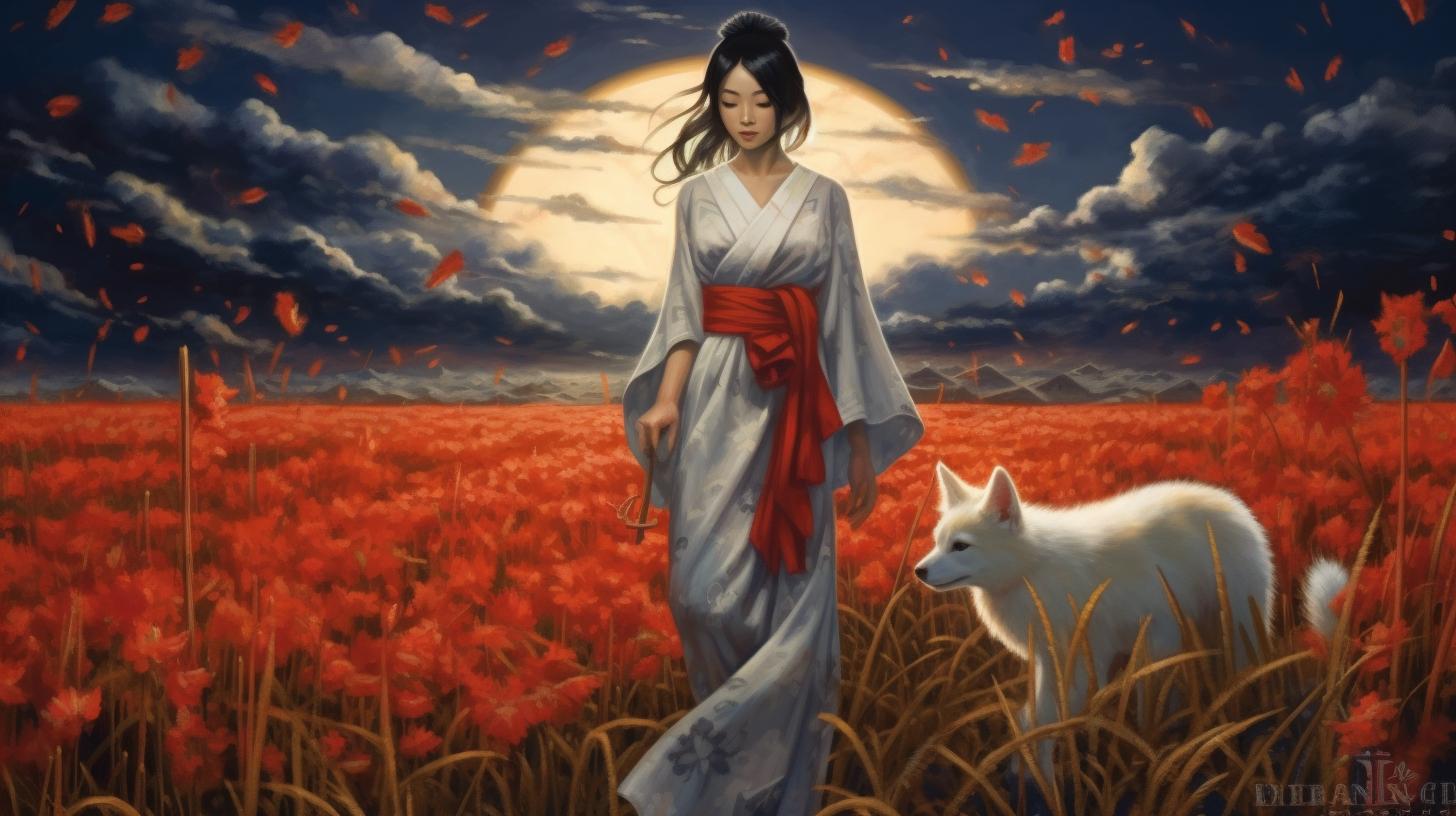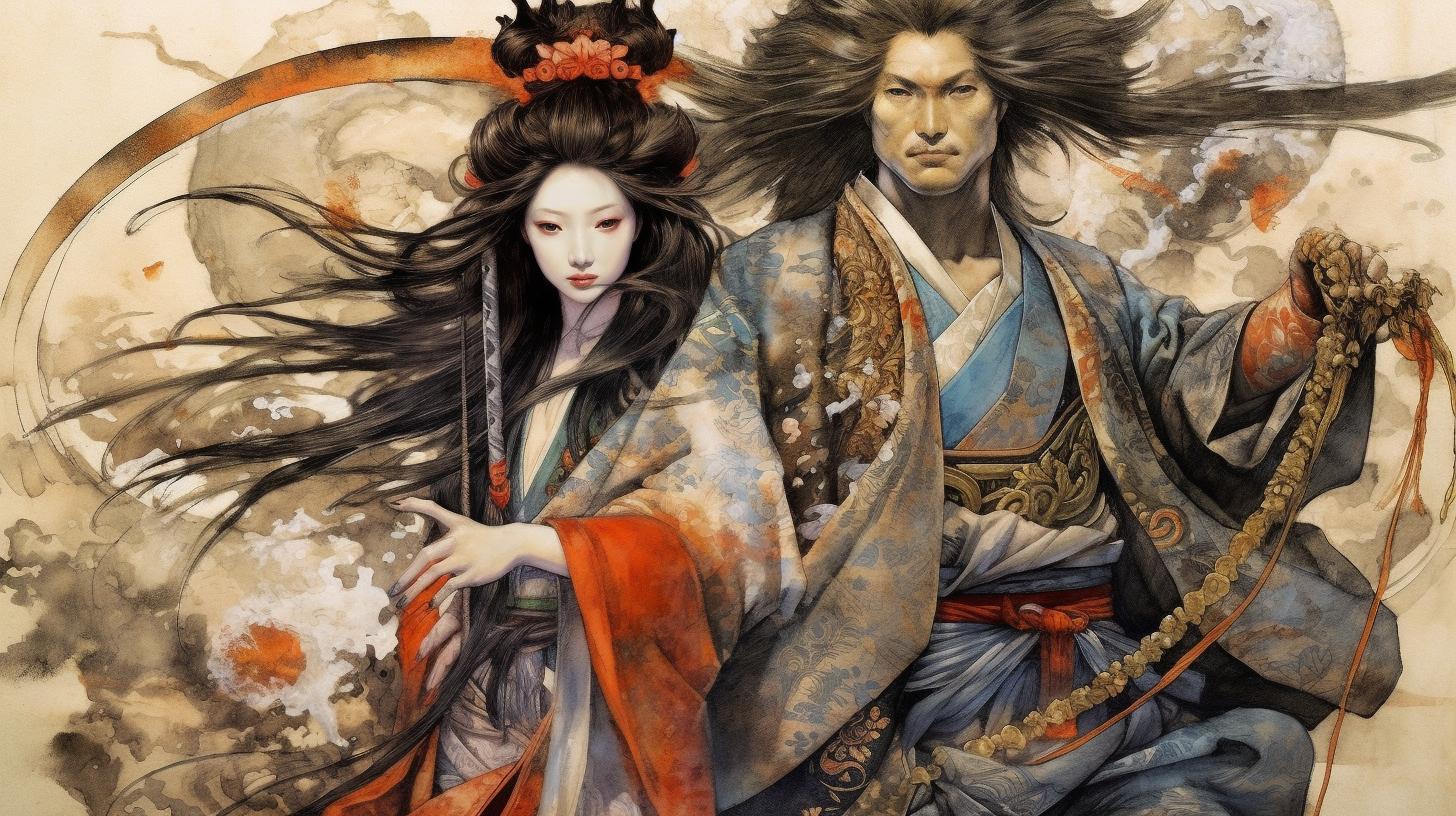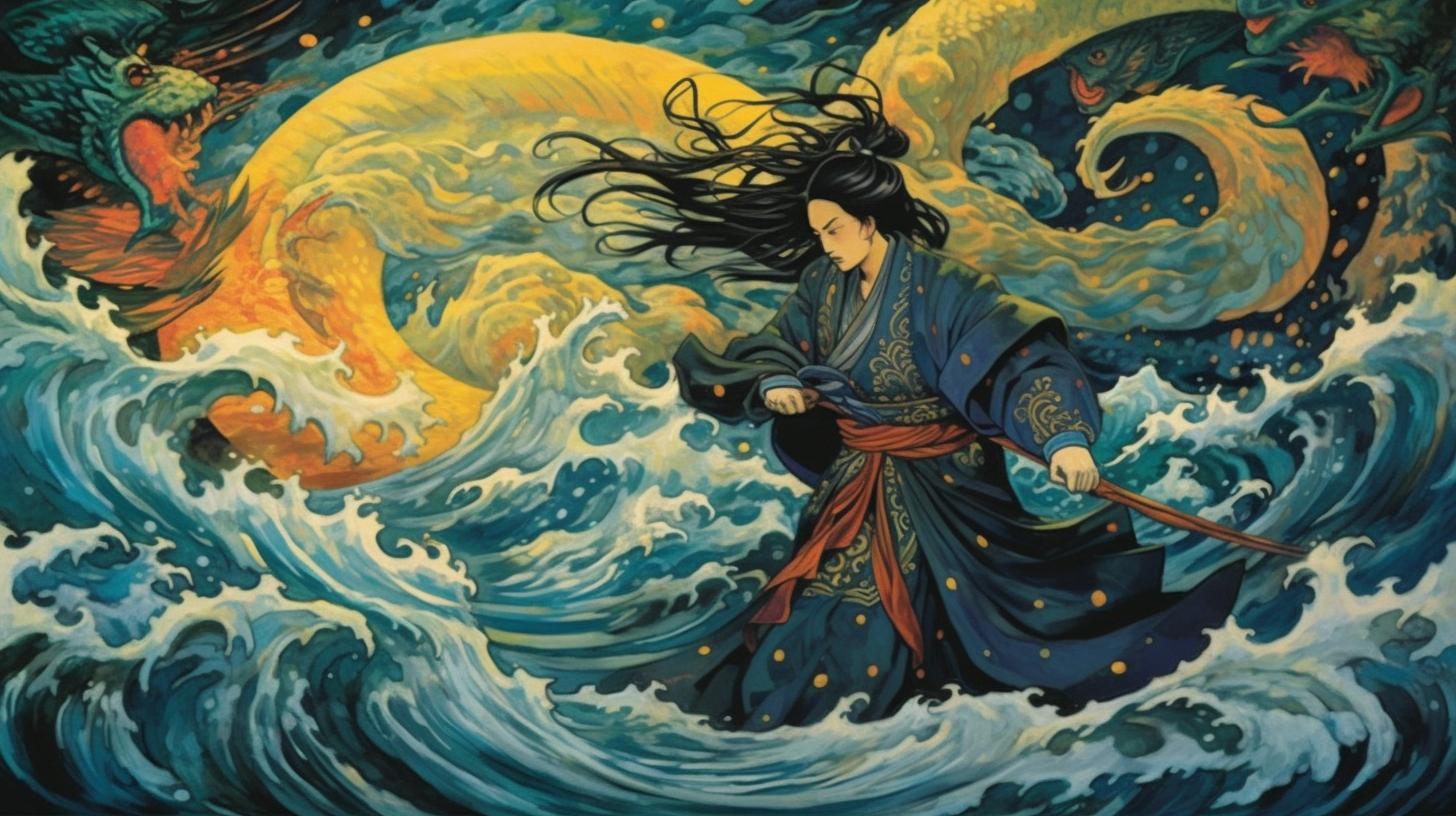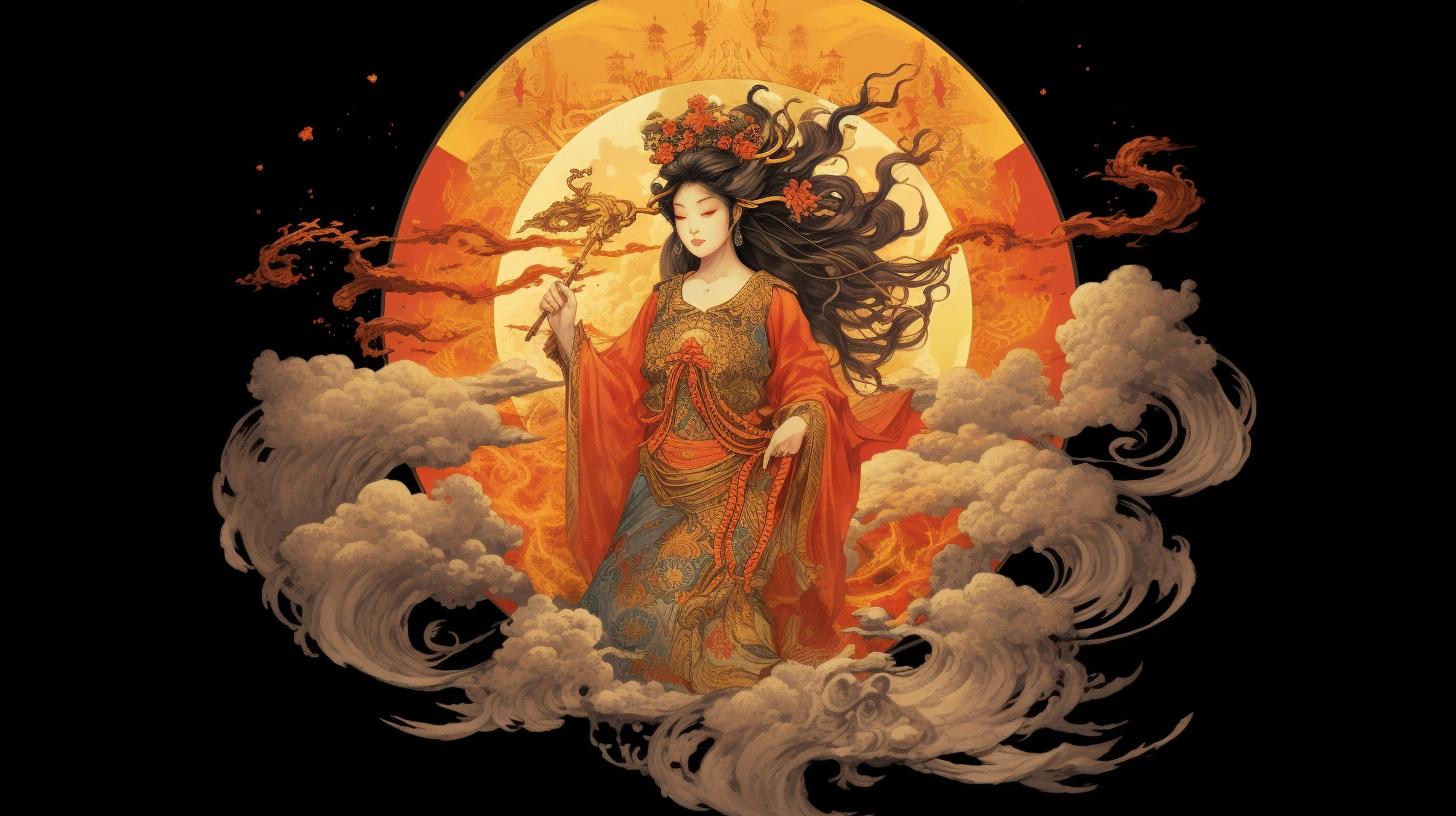All You Need To Know About The Ancient Japanese Gods and Goddesses
The world of Japanese mythology is a world of gods, goddesses, and supernatural beings. These divine spirits have played an important role in shaping Japanese culture and traditions. From Amaterasu, the goddess of the sun and ancestor of the Imperial Family, to the Siete Dioses de la Suerte (Seven Lucky Gods), Japanese gods and goddesses are greatly revered in Japan.
Lesser-known deities like Ebisu, the god of luck and fortune, and Inari, the deity of fertility, also hold significant importance in Japanese culture. These gods and goddesses have been depicted in art, celebrated in festivals, and venerated at temples and shrines throughout Japan.
In this article, we will explore some of the most popular Japanese gods and goddesses, highlighing their myths, legends, and cultural significance.
The Most Popular Japanese Gods and Goddesses
The Japanese pantheon of gods and goddesses is populated by a plethora of interesting and powerful figures that have shaped the mythology and culture of Japan. From the goddess of the sun to the god of storms, each deity has their own unique qualities and characteristics that have captivated the imaginations of people for centuries.
In this section, we will explore the most popular Japanese gods and goddesses who have played a significant role in Japanese mythology and culture.
Amaterasu – The Japanese Goddess of the Rising Sun
Amaterasu is perhaps one of the most well-known deities in Japanese mythology. She is considered the goddess of the sun, as well as an ancestor of the Japanese imperial family.
Amaterasu is also associated with rejuvenation, fertility, and harvest.
According to legend, Amaterasu was angered by her brother Susanoo’s misbehavior and retreated into a cave, causing the world to become shrouded in darkness. The other gods convinced her to come out of the cave by throwing a party, and she emerged, bringing the sunshine back to the world.
Susanoo – The Japanese God of Seas and Storms
Along the way, he encountered a dragon who was terrifying a local princess.
Susanoo bravely defeated the dragon and won the heart of the princess.
Tsukiyomi – The Japanese God of the Moon
Tsukiyomi is the god of the moon and is often worshipped in conjunction with the sun goddess Amaterasu. He is known for his stoic nature and dedication to his role in the cosmos.
Tsukiyomi is also associated with the purification of the spirit and the reflection of oneself. According to legend, Tsukiyomi was created when Izanagi, the god of creation, washed his face after emerging from the underworld.
Kagutsuchi – The Japanese God of Destructive Fire
Kagutsuchi is the god of destructive fire and is often portrayed as a fierce and destructive force. He is said to have been born fully formed from the blood of his mother, who died giving birth to him.
Kagutsuchi‘s fire was so powerful that it killed his own father, Izanagi. However, he was also responsible for creating new land by causing volcanic eruptions. As a result, he is often associated with both destruction and creation.
Bishamonten – The Japanese God of War and Fortune
Bishamonten is the god of war and fortune and is one of the seven gods of fortune in Japanese mythology. He is often depicted in armor holding a spear and is believed to protect people from disease and misfortune.
Bishamonten is also associated with wealth and prosperity and is said to have the power to change one’s fortunes for the better. According to legend, Bishamonten was a dragon slayer who was worshipped by the emperor as a powerful and benevolent deity.
Ebisu – The Japanese God of Luck and Fortune
Ebisu is typically depicted with a fishing rod in one hand and a sea bream (a symbol of good luck) in the other. He is known as the god of fishermen and was originally worshiped by those who made their living on the sea.
However, over time, his popularity grew, and he became associated with luck and prosperity more broadly. Today, Ebisu is thought to bring good luck and success to those who worship him.
His iconic image can be found in businesses and homes throughout Japan, and he is often invoked during New Year celebrations and other important events.
Inari – The Japanese Deity of Fertility and Foxes
Inari, the deity of fertility and foxes, is one of the most enigmatic and fascinating figures in Japanese mythology. Often depicted as a beautiful woman or a fox with multiple tails, Inari is a complex and multifaceted deity with a long and storied history.
Inari is associated with fertility, agriculture, and prosperity, and is often regarded as the patron of farmers and merchants. She is also closely associated with foxes, which are considered sacred animals in Japan.
Inari‘s shrines often feature fox statues and images of the deity herself with foxes at her side. Inari is also known for her connection to the kitsune-mochi, or fox spirit mediums, who are said to be able to communicate with and control the fox spirits that are believed to inhabit the world.
Kitsune-mochi were often employed by farmers to protect their crops from pests and other threats.
Hotei the Laughing Buddha – A Benevolent Japanese God of Good Luck and Wealth
He is known for his jolly, cheerful demeanor and his oversized stomach, which is said to symbolize his happiness and contentment.
Hotei is regarded as a patron of the poor and the downtrodden, and is often depicted with a large bag of gifts and treasures, which he distributes to those in need.
From bringing good luck and prosperity to protecting crops and encouraging fertility, these kami continue to inspire and captivate the imaginations of people throughout Japan and around the world.
The Seven Lucky Gods in Japanese Mythology
Ebisu
Ebisu is the Japanese god of luck and fortune and is one of the Seven Lucky Gods. He is often depicted wearing a tall hat and carrying a fishing rod and a sea bream, which is a symbol of good luck.
Ebisu is also associated with commerce and industry, making him a popular deity among businessmen and merchants. He is typically depicted as a cheerful and kind-hearted god who brings prosperity and success to those who pray to him.
Daikokuten – The Japanese God of Agriculture and Wealth
Daikokuten is the Japanese god of agriculture and wealth and is also one of the Seven Lucky Gods. He is often depicted with a large sack of rice on his back, a symbol of his role in agriculture, and a hammer, symbolizing his association with business and commerce.
Daikokuten is a popular deity among farmers and businessmen, as he is believed to bring bountiful harvests and financial success.
Bishamonten
Bishamonten is also associated with justice and protection, making him a popular deity among samurai and those who seek safety and security in their lives.
Benzaiten – The Japanese Goddess of Arts and Wisdom
Benzaiten is also associated with love and beauty, making her a popular deity among those who seek fulfillment in their relationships.
Fukurokuju – The Japanese God of Longevity
Fukurokuju is the Japanese god of longevity and is one of the Seven Lucky Gods. He is often depicted as an old man with a long white beard and is associated with wisdom and good fortune.
Fukurokuju is also believed to bring happiness and wealth to those who pray to him.
Hotei the Laughing Buddha
Hotei is a benevolent Japanese god of good luck and wealth, and is often depicted as the Laughing Buddha, with a large belly and jolly expression. He is also one of the Seven Lucky Gods and is believed to bring good fortune and happiness to those who pray to him.
Jurojin – The Japanese God of the Southern Polestar
Jurojin is the Japanese god of the Southern Polestar and is one of the Seven Lucky Gods. He is often depicted as an old man with a long white beard and is associated with longevity and wisdom.
These Seven Lucky Gods are revered throughout Japan, and it is common to see their images displayed in homes, businesses, and temples.
They are believed to bring good fortune, prosperity, and happiness to those who venerate them, making them an important part of Japanese mythology and culture.
Japanese Mythology: Creation Myths and Legends
According to Japanese mythology, the world began with the creation of two divine beings: Izanagi and Izanami. They were tasked with creating the Japanese islands and populating them with a diverse array of creatures.
The story of their creation begins as the two gods stood on the bridge between heaven and earth. Izanagi used his staff to stir the chaotic sea below them, and as he lifted it out of the water, drops fell from the tip and formed the first island, Onogoro.
The two gods married and followed the ritual for creating new life. However, when Izanami gave birth to the fire god Kagutsuchi, he burned her so badly that she died.
Izanagi was so grief-stricken that he journeyed to Yomi, the underworld, to find her and bring her back. However, he ultimately failed in his quest and was forced to flee back to the world above.
As he cleansed himself after his journey, Izanagi created a series of gods, including Amaterasu, Tsukiyomi, and Susanoo, from his own body. These new gods would shape Japan and its people.
How Amaterasu Brought Light Back to the World from a Cave
One of the most famous Japanese myths revolves around Amaterasu, the goddess of the sun. According to the legend, her brother Susanoo went on a rampage, destroying her rice fields and throwing the divine horses into her weaving hall.
Angry and ashamed, Amaterasu retreated into a cave, plunging the world into darkness. The other gods and goddesses tried everything they could think of to lure her out, but she refused to leave.
Finally, Uzume, the goddess of laughter and merriment, devised a plan to entice Amaterasu out of the cave. She took a large barrel and turned it over, then began to dance on it and sing.
The other gods joined in with music and clapping, and before long, Amaterasu peeked out of the cave to see what was happening. As she did, the god Ame-no-Tajikarawo, who had been hiding behind the barrel, grabbed her hand and pulled her out of the cave.
When she emerged, the other gods held up a mirror, which reflected her bright and radiant image. Blinded by her own beauty, Amaterasu stepped closer to look at the reflection, and the other gods quickly closed the cave behind her.
With Amaterasu back in the sky, the world was once again filled with light and warmth.
The First Emperor of Japan: A Divine Ancestor of Amaterasu
According to legend, the first emperor of Japan, Emperor Jimmu, was a direct descendant of Amaterasu. The story goes that Jimmu was born on February 13, 711 BCE, and was the great-great-grandson of Ninigi, another one of Amaterasu’s descendants.
Jimmu’s mother, Tamayori-hime, was the daughter of a sea god and was known for her beauty and grace. When she died shortly after Jimmu’s birth, he was raised by his father, Ugayafukiaezu, until he was old enough to lead his people.
Jimmu’s reign was marked by expansion and conquest, as he led his armies across the Japanese islands, subduing rival tribes and establishing his rule over a unified Japan. Despite the challenges he faced, Jimmu’s divine ancestry and the blessings of Amaterasu were said to have given him the strength and wisdom he needed to succeed.
Today, the Japanese Imperial Family claims direct descent from Emperor Jimmu and Amaterasu. Their ancestral connection to the goddess of the sun represents a deep connection to Japanese mythology and a powerful symbol of national unity.
Japanese Gods and Goddesses in Japanese Culture
The Japanese Imperial Family and Their Ancestral Connection to Amaterasu
The Japanese Imperial Family traces their ancestry back to Amaterasu, the goddess of the sun and the most important figure in Japanese mythology. According to legend, Amaterasu’s grandson, Ninigi-no-Mikoto, descended from heaven to become the first emperor of Japan.
As a result of this divine lineage, members of the imperial family are seen as living representatives of the kami, or divine spirits, and hold great respect and reverence within Japanese society.
The imperial family participates in numerous religious and cultural events throughout the year, many of which are dedicated to the worship of Shinto gods and goddesses, such as Amaterasu.
Japanese Gods and Goddesses in Buddhist Temples and Shrines
Japanese Buddhism has long been influenced by the mythology and folklore of Shintoism, resulting in the blending of these two religious traditions. This has led to the incorporation of Shinto gods and goddesses into Buddhist temples and shrines throughout the country.
For example, Inari, the Shinto deity of fertility and foxes, is often syncretized with the Buddhist bodhisattva Jizō as Inari Jizō. Similarly, Bishamonten, the Shinto god of war and fortune, is also worshipped in Buddhist temples throughout Japan as a protector of the dharma, or Buddhist teachings.
The shared veneration of these divine spirits has helped to forge a unique religious and cultural identity in Japan.
Japanese Gods and Goddesses in Japanese Art
Japanese gods and goddesses have played a significant role in Japanese art for centuries, with depictions of these divine beings appearing in a wide range of mediums, including sculpture, painting, and woodblock prints.
Japanese artists often draw inspiration from mythology and folklore and incorporate these stories and legends into their work. For example, ukiyo-e, a popular art form in Japan during the Edo period, often featured images of the Seven Lucky Gods, a group of deities who were believed to bring good luck and fortune.
Many of these artworks can still be seen today in museums and art galleries throughout Japan, providing a glimpse into the rich cultural history of the country….





